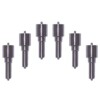Power Driven 12v Nozzle Set
$138.60 – $396.00
-
- Power Driven 12v Nozzle Set (60000001009)
Features:
- Proven performance nozzles
- Set of 6
- Compatible for years 1991-1998 if installed on 7 mm bodies
- Comes with a full installation kit
Installation kit includes:
- Copper sealing washers
- Horseshoe/fuel return washers
- Dust seals/caps
12v Cummins Injector Shim Kit

This product cannot ship to California

Power Driven Diesel nozzles are offered as an economical option for those wanting to assemble their own injectors. From daily drivers, to work trucks, to dedicated competition vehicles, our nozzles have proven themselves. Each Power Driven 12v Nozzle Set Nozzle Set comes with new sealing washers, drain manifold washers, and dust seals.
Check out this video for more information:
Would you like to know more? Our tech support staff frequently receives these common questions about injectors:
What’s the difference between 5-hole, 6-hole, and 7-hole nozzles?
For a given flow amount, a nozzle with a smaller number of holes and a larger hole size will develop a more powerful jet of fuel, which will penetrate deeper into the piston bowl. This means the fuel jet will have some resistance to ignition until it is farther into the bowl. Conversely, a nozzle of the same flow amount, but with a larger number of holes and smaller hole size will produce a finer spray of fuel, which doesn’t penetrate as far into the bowl but ignites more readily. The amount of bowl penetration that is ideal depends on the rpm and boost level of the application.
At low rpm, the 7-hole nozzle atomizes the fuel into the charge air better, which results in increased burn efficiency. However, there is a crossover point around 2,000 rpm where the deeper penetration of the 5-hole nozzle is required to maintain burn efficiency at higher levels of boost and rpm, as the charge air conditions in the bowl become increasingly dense and turbulent. While apparent, these differences between the 5 and 7-holes are minimal until 3,000 rpm. Overall, the 5-hole nozzle is by far the most common and is the best choice for most 12v applications. 7-hole nozzles may perform better on lightly loaded trucks running at lower rpm.
Which is better, SAC or VCO nozzles?
For the best explanation and demonstration of nozzle types, check out the video below!
What is the spray angle, and which one is right for me?
The spray angle, or spray pattern, is another variable in the injector equation. This refers to the built-in cone angle of the injector nozzle itself. Normally, the nozzle’s spray angle and piston bowls should be matched for optimal performance. Generally, second-gen 12v trucks with stock pistons will run best with a 145-degree spray angle. When mixing and matching spray angles and piston bowls, one must be careful. Putting 155-degree injectors in an engine with 145-degree pistons will result in high EGTs and a very hazy, smokey exhaust due to the fuel spraying outside the bowl. The notorious marine 370 hp injectors used in days past have a 155-degree spray pattern, and they gave performance injectors a bad name for a long time. On the other hand, we have had good results running 145-degree injectors in 155-degree piston bowls. This is especially apparent on builds with high injection timing.
Today, we offer a wide assortment of performance nozzles with spray angles tailored to your application.
| Weight | 1.5 lbs |
|---|---|
| Dimensions | N/A |
| Size | 5x.010, 5x.011, 5x.012, 5x.013, 5x.014, 5x.016, 5x.017, 5x.018, 5x.020, 5x.022, 6x.010, 6x.011, 7x.009, 7x.010, 7x.011 |
| Nozzles | SAC, VCO |
| Spray Pattern | 145, 148, 150, 155 |
Be the first to review “Power Driven 12v Nozzle Set” Cancel reply
This site uses Akismet to reduce spam. Learn how your comment data is processed.




Reviews
There are no reviews yet.